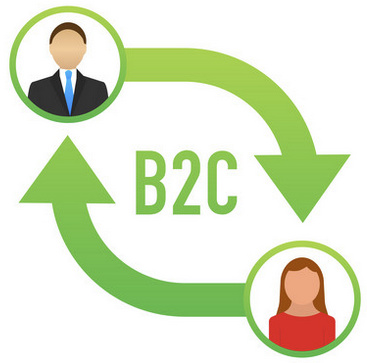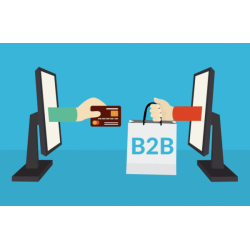
The e-Commerce, a service offered by the web for several decades now and in continuous growth, differs mainly in three categories recognizable by these abbreviations: B2C, B2B and C2C.
 B2C e-Commerce or Business To Consumer is the most widely used business model on the web as well as for its namesake in real life. In practice companies and enterprises produce goods and services according to the demand of the private individual who then buys and uses them. The realization of this type of e-Commerce requires the maximum effort for many reasons. Among the many, it is necessary to consider the fact that the best experience for the end user must be guaranteed. Being the audience of users, the widest and most varied, it is clear that ensuring the best experience to everyone is not such an obvious task. It's not enough to have attractive graphics or the latest graphic icons, but you also need to ensure a good ease in reaching the content and therefore ease in completing your order smoothly and even as quickly as possible. The aseptti that determine a good end user experience, are many and vary depending on the market segment in which you intend to operate. The solutions that we adopt to satisfy this kind of e-Commerce have allowed different realities to bill excellent profits in a simple safe and above all very durable way.
B2C e-Commerce or Business To Consumer is the most widely used business model on the web as well as for its namesake in real life. In practice companies and enterprises produce goods and services according to the demand of the private individual who then buys and uses them. The realization of this type of e-Commerce requires the maximum effort for many reasons. Among the many, it is necessary to consider the fact that the best experience for the end user must be guaranteed. Being the audience of users, the widest and most varied, it is clear that ensuring the best experience to everyone is not such an obvious task. It's not enough to have attractive graphics or the latest graphic icons, but you also need to ensure a good ease in reaching the content and therefore ease in completing your order smoothly and even as quickly as possible. The aseptti that determine a good end user experience, are many and vary depending on the market segment in which you intend to operate. The solutions that we adopt to satisfy this kind of e-Commerce have allowed different realities to bill excellent profits in a simple safe and above all very durable way.
 A B2B e-Commerce or Business to Business differs from the nominal B2C due to the fact that sales are basically reserved for professionals. The catalog even if it is public, it usually keeps reserved the prices therefore the various lists and the quantities in stock, the catalog can also be composed of lots of products and only the professionals registered after the authentication can know the details of the catalog and then make purchases. Generally the applications of type B2B offer the possibility to easily import or export massive price lists from electronic catalogs also automating the loading and / or update operations, it is also often offered the possibility to integrate the interface with the various marketpalce facilitating and simplifying the activities of trade on a large scale. A last aspect not to be underestimated is finally that of the administration, often in fact many applications integrate a management of users not very transparent making the organization and distribution of rights and credentials for access to staff, a task far from easy. DEV74 offers a solution designed to facilitate all these features mentioned above that allows you to get concrete results in a short time.
A B2B e-Commerce or Business to Business differs from the nominal B2C due to the fact that sales are basically reserved for professionals. The catalog even if it is public, it usually keeps reserved the prices therefore the various lists and the quantities in stock, the catalog can also be composed of lots of products and only the professionals registered after the authentication can know the details of the catalog and then make purchases. Generally the applications of type B2B offer the possibility to easily import or export massive price lists from electronic catalogs also automating the loading and / or update operations, it is also often offered the possibility to integrate the interface with the various marketpalce facilitating and simplifying the activities of trade on a large scale. A last aspect not to be underestimated is finally that of the administration, often in fact many applications integrate a management of users not very transparent making the organization and distribution of rights and credentials for access to staff, a task far from easy. DEV74 offers a solution designed to facilitate all these features mentioned above that allows you to get concrete results in a short time.
 Unlike other models, this type of e-Commerce mainly involves private actors. The operation consists of matching offers and demands between private parties and thus completing as many such transactions as possible. In other words, to simplify and render the idea, we could take as a practical example the classic "flea markets" where private individuals can publish their products and/or services that they intend to offer to third parties. Also in this case the success of this type of services depends very much on the care with which is organized and structured the portal where users will interact. For this kind of services there are CMS applications designed and developed specifically to develop services for the purchase and sale of tangible or intangible assets between private individuals by integrating dedicated premium features without neglecting all the aspect related to security and fraud containment. The study and experience gained for this type of application, specifically dedicated to providing services for this type of interaction, allows us to realize C2C projects of high level and sophistication.
Unlike other models, this type of e-Commerce mainly involves private actors. The operation consists of matching offers and demands between private parties and thus completing as many such transactions as possible. In other words, to simplify and render the idea, we could take as a practical example the classic "flea markets" where private individuals can publish their products and/or services that they intend to offer to third parties. Also in this case the success of this type of services depends very much on the care with which is organized and structured the portal where users will interact. For this kind of services there are CMS applications designed and developed specifically to develop services for the purchase and sale of tangible or intangible assets between private individuals by integrating dedicated premium features without neglecting all the aspect related to security and fraud containment. The study and experience gained for this type of application, specifically dedicated to providing services for this type of interaction, allows us to realize C2C projects of high level and sophistication.
A typical feature of B2C and B2B e-Commerce that further characterizes its operation is commonly called "DropShipping", i.e. an e-Commerce in DropSchipping is said to be such when the items in its catalog are not stored at its warehouse but remain in stock at the wholesaler of reference. In this case the online store buys the products only in case it receives the order from the final customer. When this happens the order of the end customer is turned to the wholesaler with the appropriate adjustments of the case, which ships directly to the end customer. This kind of e-Commerce needs a structure dedicated to the import of price lists and catalogs and with a good automation of the catalog updating processes in order to guarantee to the public all the stock values and prices constantly updated and in line with those of the wholesaler. These synchronizations not only serve to guarantee the latest news to the end customer but also to avoid the cases in which the order is placed for products not in stock at the wholesaler but otherwise available on the affiliated e-Commerce.




Leave a Comment